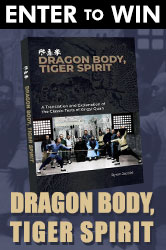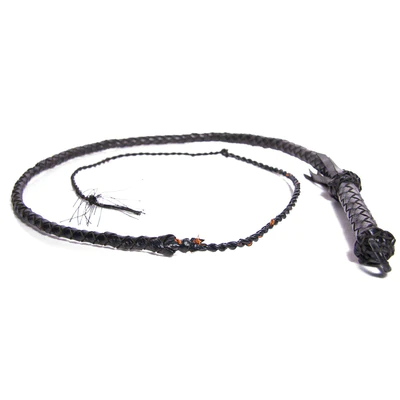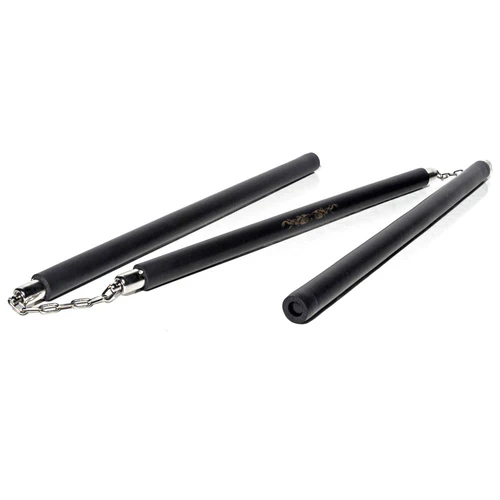Tai chi chuan is one of the true treasures of traditional Chinese culture. It combines philosophy, religion, art, military affairs, physical education and medicine through thousands of years of evolution and development. It is an excellent physical system with not only theoretical but also practical value. Vast and profound, it is simple and easy to perform and embraces both defense and offense. It is a health-promoting exercise with a high level of grace and beauty invented by the Chinese during a long history of practical daily living and developed into the chuan shei fa, a method of Chinese boxing. In 1700 BC, the book of "Chou-Yi" recorded the principles of tai chi, and even before such writing there had been another extended period whereby information was handed down generation to generation by word of mouth.
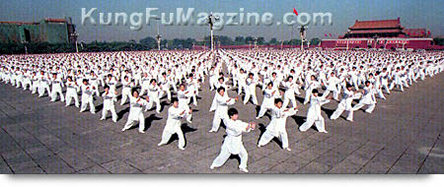
The Unique Process
Tai chi chuan, in the process of its exercises, always accommodates its yin/yang and veiled concreteness in expressing its action; every hand holds an open/close, round/square, push/pull, real/fake, heavy/light, tough/soft, and quick/slow. In addition, expediting its movement requires uniting from both extremes - the left/right, up/down, in/out, grand/puny, and advance/retreat, in a unique process.
In external appearance, tai chi chuan has its distinction. However, nei kung, the internal force, also possesses unique specifications. While practicing, one must pay attention to the use of one's will, instead of brute force. This is the only exercise that uses the will to refine the will.
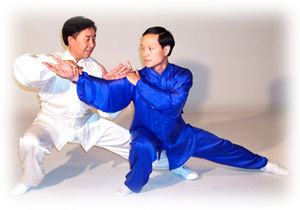 On the inside, tai chi chuan is an exercise of the will and the chi - a flow from within. On the outside, it is a proud and mobile exercise that also allows you to practice both the will and the chi. This is the essence of tai chi chuan. In performing tai chi chuan, one must raise the head and relax the body while encompassing the pros and cons. One movement brings with it all the movements like that of a silkworm spinning thread, a moving cloud, or a flowing stream reaching its goal in one swift stroke. In between, briskness and lingering, rigidity and flexibility complement each other. Even when the brute force has ceased, the will continues.
On the inside, tai chi chuan is an exercise of the will and the chi - a flow from within. On the outside, it is a proud and mobile exercise that also allows you to practice both the will and the chi. This is the essence of tai chi chuan. In performing tai chi chuan, one must raise the head and relax the body while encompassing the pros and cons. One movement brings with it all the movements like that of a silkworm spinning thread, a moving cloud, or a flowing stream reaching its goal in one swift stroke. In between, briskness and lingering, rigidity and flexibility complement each other. Even when the brute force has ceased, the will continues.
While the will has stopped, the spirit is still connected in force. With body erect and center maintained, the hands can reach all directions. Abstractness and concreteness both carry in their beginning, as well as open and close. With the aforementioned performance condition, tai chi chuan can then demonstrate, maximally, its extraordinary effects. In health maintenance, it will help regulate the central nervous system and increase the functional capacity of the musculoskeletal and other organ systems. Furthermore, it will train and strengthen the control of one's will, utilizing the will instead of brute force.
Soothing the Body
Once the will and chi boost each other and expand, it will allow the body to fill with the energy of defense. The evil and foreign cannot invade, or, the augmented immunity will allow no disease to infiltrate. On treating chronic illnesses, because the will and the chi flow through points of nerve centers, tai chi chuan utilizes the regulation of the inner flow and the external physical movements to soothe the entire body, therefore reaching the goal of ridding the illness and permitting the body to recover and fortify.
When executing this art with the will, a certain level of realization will be accomplished. Combined with its standard moves, one will maintain a balance between body and mind, achieving a harmonized happiness in true health. On techniques, tai chi chuan also possesses a unique effect: from motion evolves tranquility, serenity overrides the motion; tardy hands touch first, flexibility overcomes the hard. If the opponent does not move, one does not move. But, if the opponent makes a move, one must make it before him. The principle is that you must be quicker; the first one to hit, attaining the standard of a delayed output, striking first, by knowing both your opponent and yourself.
The driving flow of chi is a constant moving ball encompassing every minute corner and the will drives it. Whenever one wishes, one may instantaneously explode with an enormous physical capability. Merging with a well-regulated external power martial art, one will rise up to a high-level technique that is as sharp cutting as refined steel.
Tai Chi Chuan is a longstanding product of the ancient Chinese traditional culture, and once it endures the scrutiny and organization of modern science it will help develop the relationship between our human brain and the universe, and produce a stupendous impact in revealing the secret of life.
NASA Plan
 The National Aeronautics and Space Administration (NASA) undertook all methods of modern exercise to train astronauts to adapt to the outer space environment, but it met with little efficacy. NASA then employed the discipline of tai chi chuan, and received excellent results. Actually, the astronauts merely train with the forms of tai chi. However, the essence of tai chi chuan is to purify the will, train with both the mind and the form. The mind, being the theme, takes the lead.
The National Aeronautics and Space Administration (NASA) undertook all methods of modern exercise to train astronauts to adapt to the outer space environment, but it met with little efficacy. NASA then employed the discipline of tai chi chuan, and received excellent results. Actually, the astronauts merely train with the forms of tai chi. However, the essence of tai chi chuan is to purify the will, train with both the mind and the form. The mind, being the theme, takes the lead.
The goal of instruction of physical form should follow the purpose of mental discipline. Recently, in every area of sports, all around the world, many coaches are beginning to require their athletes to participate in mental exercise. Before every competition or training season, athletes may practice yoga or receive massage in search of a better performance. The outcome, in contrast to tai chi or chi kung, is only scratching the surface. Using tai chi chuan or chi kung to drive the will is truly the highest level of psychological training.
The unique, graceful moves of tai chi chuan involve the formulated expression of high-value aestheticism, bringing to us the appreciation of beauty as well as a spiritual enlightenment. Looking at the numerous ways of expression of the Chinese art, drawing, calligraphy, opera, folk acrobatics, and choreography, one realizes that the Chinese martial arts entail and exhibit overwhelming fervor that owes its influence to all of the above.
Elevating the Standard
Generally speaking, the development of contemporary sports is one of mechanical exercise. With this circle of limitation as its potential to approach its confines, it is very difficult to raise one's level beyond it. As in sprints, high jump, broad jump and swimming, gaining even a few tenths of a second or a few centimeters is extremely difficult. The further advances of sports can only lead to elevation of the standard of mental training, or raising the level of our senses' command. Making this unity possible, tai chi chuan definitely could become the new wave as a leader in modern sports and exercise.
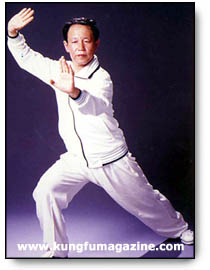 Tai chi chuan is called the exercise of the elderly. Life beyond thirty enters a prime era; however, the rate of metabolism is reduced in inverse proportion. At this time, if one still attempts heavy exercise to reach his goal, one will head in the opposite direction. The intense action of modern exercise expends too much physical energy, and will deplete our reserves. Meanwhile, tai chi chuan will refine both the spiritual and physical life. Our organ systems and the soul will gain proper adjustments and healing. Also, the benefits from tai chi chuan exercises can displace the true fatigue brought about by a daily, tiring workload.
Tai chi chuan is called the exercise of the elderly. Life beyond thirty enters a prime era; however, the rate of metabolism is reduced in inverse proportion. At this time, if one still attempts heavy exercise to reach his goal, one will head in the opposite direction. The intense action of modern exercise expends too much physical energy, and will deplete our reserves. Meanwhile, tai chi chuan will refine both the spiritual and physical life. Our organ systems and the soul will gain proper adjustments and healing. Also, the benefits from tai chi chuan exercises can displace the true fatigue brought about by a daily, tiring workload.
The Principles of Tai Chi Chuan, by Tzung-Yueh Wang, categorized each school of tai chi chuan by different tai chi philosophy and organized the writings on tai chi chuan maneuvers by their diverse theories. It mentions that one who knows tai chi grows from neither extreme, and in between this movement and stillness lies the origin to both yin and yang. Only when one holds the capacity to separate and unite the yin/yang, can he gain the true understanding of tai chi. Under the principle of "generalization with the preservation of subtle differences, " one may develop tai chi into an even higher level. It is not a distinction as to which branches are a true tai chi and which are not. Be it any school or any person, as long as he has the tai chi senses and forces, he has the true tai chi. Otherwise it is not true tai chi, no matter who he may be or whether or not he inherited an ancestral technique. Looking back through the history of Chinese martial arts' development, the internal and external schools in kung-fu originate from the same source, the same family. They (internal and external) should be incorporated and presented to the international community under one common designation as an interminable but also new force -- Chinese tai chi chuan.
Wang Shi-Qing
Wang Shi Qing was born in the Liaoning province of China, 1956. In 1964 Master Wang began his training in martial arts at the tender age of eight under the guidance of his grandfather, who taught Wang the basic exercises of Shaolin kung fu. Later on when Wang attended high school he continued his kung fu training under a master by the name of Nie Shen-Qi. He taught Wang a style called Cha Chuan (famous local fist). Wang would learn this style in just three years, but his desire to learn more grew stronger. Eventually, Wang became aware of the internal martial arts and their exceptional qualities in not only promoting good health, but also their superior fighting skills.
Being a perfectionist, Wang pursued the internal arts in a scholarly way, leaving no stone unturned, and he sought out the most famous masters China had to offer. During Wang's journey into these arts he kept hearing about a not-so-famous master named Zhang Kui-Wen whose lineage in Xing-Yi, Bagua and Taiji were very pure, rare and closely linked to the founders of these great styles. Due to the politically unstable atmosphere in China during the Cultural Revolution, Master Zhang was very reclusive and his whereabouts were unknown. Wang's dream to meet Master Zhang began to blossom when one day by chance he met someone who told him that Zhang was a watch repairman who worked out of his home located in Shenyang City in east China. It wasn't long before Wang tracked down Master Zhang and set out to meet the man he had heard so many good things about. It took several months before Master Zhang would agree to accept Wang as his pupil. Wang would learn later that Zhang was imprisoned in 1969 because fanatical people wanted to punish him just for teaching martial arts. It didn't take Wang long to realize he was in the presence of a truly high-level master.
In 1972 Master Zhang began to secretly teach Wang behind closed doors. (This is often called being an "inner door" or "closed door" student). He taught Wang several styles including Mi-Zong, "Lost Track" boxing, a style that focuses on using internal energy along with hand and foot coordination. Once Wang finished his training in Mi-Zong, Zhang would then pass on to him his Xing-Yi, Bagua and several styles of Taiji, Wu/Hao and Yang Pan Hao. Later Wang would also learn Sun Taiji from another teacher named He Fu-Fheng. (All of these are small-frame styles). Wang would come to find out that Master Zhang's lineage in Bagua and Taiji were in fact closely linked to the founders. Zhang began training in Bagua under 3rd generation grandmaster Jiang Song-Yan at age nine. Years later, Zhang would learn the Yang Pan-Hao and the Wu/Hao styles of Taijiquan under 4th generation grandmaster Yan Zhi-Gao.
18 Gold Medals
It was in 1982 that Wang decided to make martial arts his career, and decided to test all the skills Master Zhang had instilled in him. He entered into the tournament circuit, competing in national and international competitions, dominating almost every tournament he entered, going on to win 18 gold medals in free fighting as well as forms. In 1985 Wang became the all-China traditional Xing-Yi Quan champion, all-China national Taiji push hands, (tui shou), and "San Shou" champion. In 1988 Wang competed in Japan and became a three-time international champion there. While in Japan, Wang was invited to teach his arts there. He accepted and opened the first school of Wu Dang Internal Martial Arts. With the success of that school, Wang decided to come to America and open another school. In 1991 Wang opened his second school in Southern California's Temple City and continues to teach the Wu Dang Internal Arts, encouraging his students to learn all three of the internal arts, Xingyiquan, Baguazhang, and Taijiquan.
About
Wang Shi-Qing and Wayne Carisi :
![]() To contact Master Wang for instruction or seminars one may reach him at: WANG SHI-QING'S MARTIAL ARTS ACADEMY OF INTERNAL KUNG-FU, U.S. CHINESE MARTIAL ARTS ASSOCIATION, 5202 N. ROSEMEAD BOULEVARD, TEMPLE CITY, CA. 91776; Tel: (626) 291-5328 or (626) 286-2951 Wayne Carisi is a martial artist and writer based in Alhambra, California, and currently studies with Master Wang.
To contact Master Wang for instruction or seminars one may reach him at: WANG SHI-QING'S MARTIAL ARTS ACADEMY OF INTERNAL KUNG-FU, U.S. CHINESE MARTIAL ARTS ASSOCIATION, 5202 N. ROSEMEAD BOULEVARD, TEMPLE CITY, CA. 91776; Tel: (626) 291-5328 or (626) 286-2951 Wayne Carisi is a martial artist and writer based in Alhambra, California, and currently studies with Master Wang.
![]() Print Friendly Version of This Article
Print Friendly Version of This Article
